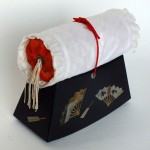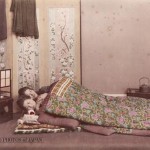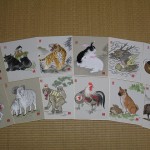Watching the Smithsonian program, “Samurai Warrior Queens,” I found myself, again, marveling at how anonymous the historians (?mostly male) kept women’s contributions — anonymous. I am reading the kokinshū for the sequel to Pillow Book of the Flower Samurai, which I am currently calling The Samurai’s Daughter. The kokinshū is a massive Imperial collection of poetry from the early 10th century. And the translators/authors of this fabulous book speak of this very thing. The anonymity of women and their contributions. In the kokinshū many of the poems’… Continue reading →
Category Archives: Japanese history
#2 IN HISTORICAL FICTION—THE STORY!
2. THE STORY What do all of these have in common: Alison Weir, Anne Perry, Ann Woodward, Laura Joh Rowland, Stephen Saylor, Elizabeth Peters, Mary Renault, the early Jean Auel, Philippa Gregory, James Melville and Diana Gabaldon? THE STORY. Amazing plot-driven, character-driven, conflict-driven, history-driven, stories. The STORY is what draws me into historical fiction and the historical background is what keeps me there. IF the history is accurate (See my previous post) i.e. no anachronisms, or egregious errors. I was reading a… Continue reading →
#1 In Historical Fiction—ACCURACY!

There are four characteristics I value in historical fiction. I’ll be talking about each one in the next few posts. 1. Most important for me is ACCURACY. I truly like the facts to be correct. For example, I noticed that Harlequin Romances was advertising for historical romance. Great. I know a little (okay, a lot) about the late Heian period. BUT. But, I am familiar with their standards. The way the romances are supposed to go—is nowhere near the path the romances of the Heian… Continue reading →
The Bow and Arrow: Another Weapon Also Used by Women
The bow and arrow provided the majority of weaponry in Heian and early Kamakura Japan. the predominance of the sword did not actually come “into” use, although it was used, until later. The actual ascendancy of the bow and arrow began during the wars before and the Genpei War. Shooting the bow and arrow became, like most of the arts in Japan, an elaborate and systematic process which required much practice. There are actually eight named stages of shooting an arrow: 1.ASHIBUMI (footing) 2. DOZUKURI… Continue reading →
Women’s Weapons: The Naginata
Between the 12th and approximately the 15th centuries women defended themselves, their families and their homes. They concealed daggers in their sleeves or sashes and delivered their deadly blades with great accuracy. Women also used the naginata, which is a pole having a long, curved sword at the top. For an ambush, women swung naginata in narrowed places, cutting the legs of horses to disable the enemy soldiers. Sometimes women fought alongside their husbands in battle. And they were expected to commit seppuku (ritual suicide)… Continue reading →
HISTORICAL FACT FROM HISTORICAL FICTION

One of the things I love about historical fiction is that I am able to learn about the historical time, people and events. So — who were the real people and who are fictional characters in Pillow Book of the Flower Samurai? Kozaishō and all of the Taira: Michimori, his family members, and even his ‘sidekick’, Tokikazu,were real. The Retired Emperor Go-Shirakawa and Antoku did live as well. As did the Minamoto: Yoshitsune, Yoritomo, Yoshitomo, Yoshinaka, Noriyori, and Yukiie. Kozaishō’s family, Akio, Toshiko, the girls on the… Continue reading →
MORE REAL FEMALE SAMURAI
By the 15th century, the role of women in Japan changed significantly. For a long time before then, women inherited their parents property, then the law of primogeniture was defended by Confucianism and Buddhism. Don’t get me started on that… More recently, the Boshin War (1868-69) also witnessed the fighting spirit of Japan’s samurai-class women. After a month-long siege, the Aizu region surrendered. Its samurai went to prisoner of war camps, and the domain was divided up and redistributed to imperial loyalists. … Continue reading →
Real Female Samurai
WERE THERE REAL SAMURAI? * * * The answer is YES! Definitely yes. Was Kozaishō a real samurai? She did really exist. She was the wife of the commander-in-chief Taira no Michimori, and according to Tale of the Heike, she was at the battle of Ichinotani. However, also with reference to the Tale of the Heike, she probably was nota samurai, but she could have been. * * * The first strong evidence of a real warrior woman is Empress Jingu who was married to… Continue reading →
More Tales and Superstitions

How We Tell Time – in Ancient Japan with the Zodiac I thought you might enjoy reading (or reading again) the story that is told to Kozaishō who learns the twelve animals of them: One day, the Emperor of Jade, the God of the heaven, declared to all the animals that he was going to choose twelve of them to name the years. The first twelve who arrived at his palace would each have the task of protecting mankind for one year. All the animals… Continue reading →
Japanese Superstitions

The Heian Period of Japan is considered the Golden Age. It is also a great age of superstition, magic and mantic practices. Did you know that the number 4 is unlucky In the Japanese culture? At the time of Pillow Book of the Flower Samurai everyone believed that the ghosts of the dead, if not properly buried and prayed for, would haunt and even kill anyone who did not honor them. The Chinese zodiac, adopted by the Japanese, which some of you may have… Continue reading →